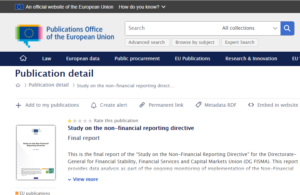I was sent details today of a 517 page ‘Final Report’ from the European Union on ‘non-financial reporting’. I have seen many references to this term over the last 10 years or so but I have never seen a clear definition of what it means (and could not find a definition here either). It tends to refer to environmental and social issues that come under the generic acronym of ‘ESG’.
The Maturity Institute’s diagnostic standard rates companies on their performance on these issues by asking a series of 32 questions (for OMINDEX). Several of these questions might appear, at first sight, to fall under the general categorisation of ‘non-financial’ – like Q.14 ‘Culture’ and Q.25 ‘Cooperation’. Such terms give accountants real problems when producing financial reports; not because they are ‘non-financial’ but simply because finance specialists have never stretched their methods enough to adequately report on the obvious, significant financial value of ‘innovative cultures’ and ‘cooperative efforts’ by employees. This report does nothing to help.
In support of this contention, and for a more through exploration of how ‘intangbles’ can be fully reported in financial value terms, see our guide for responsible management ‘The Mature Corporation’. It sets out how such reporting can be made meaningful and material, for companies and there stakeholders. It also explains why the EU has wasted much time, effort and money on its exercise. Below is a short extract from our book but let us speak plainly here – there is no such thing as ‘non-financial’ measures in any organization, except those activities that waste time and money. Every single one of the 32 Questions of OMINDEX link directly and causally to financial value and risk (the loss of value), while including all of the human issues that accounting misses.
‘The Mature Corporation – A Model of Responsble Capitalism’
Chapter 12
Redefining company reporting, valuation and responsible investing
“…for active [investment] managers, setting up as being “holier than thou” could easily backfire. ESG [Environment, Social, and Governance] might transform capitalism. It could also cause an unholy mess.” John Authers, ‘Markets Insight’ Financial Times, 31 May 2018. Opinion piece entitled “ESG investing poses big challenge for fund management industry”
It should not be hard to imagine a world in which all regulatory bodies and stock exchanges demand that every listed company be required to have a recognised “organizational health” rating to a uniform standard. Organizational health reporting can sit alongside or be integrated with traditional reporting formats on financial health and credit worthiness. The ability to make meaningful and insightful comparisons will promote change and organizational transformation for the greater good. The recognition and widespread adoption of OMINDEX ratings, embedding an underlying purpose of TSV, remains one of the Maturity Institute’s primary goals.
The opening quote in this chapter comes from a piece by John Authers’ in the Financial Times, and reflects an emerging investment paradigm where asset owners and managers are increasingly embedding additional, so called non-financial factors, into corporate valuation and stock picking. These factors include a company’s management of its environmental impact, the relationship with human and social issues arising from the company’s operations, and the nature of its own governance. This type of investing is still in its infancy but is beginning to tread a path that leads directly to mainstream fund management circles.
John Authers highlights that ESG factors have the potential to become extremely important, by offering a solution that removes financial blinkers, worn during the process of company valuation. Integrating ESG factors should have a knock-on effect on company actions and behaviours, potentially helping to cure capitalism of its own current ills, and foster a refreshed corporate reporting model that such an approach demands. Yet he also advises caution. ESG investing and its message to corporate actors remains bereft of recognised standards. It is far from a coherent framework and is inconsistently applied in practice.
Investment firms and pension funds use an array of different methods to integrate ESG factors and apply them in very different ways: from authentic attempts to pick investments using ESG, to merely showing external stakeholders an apparent commitment to responsible investing. For their part, companies report loosely and inconsistently around ESG topics, often as an adjunct to core business practice rather than integrated within overall strategy. In doing so, ESG can create an “unholy mess”, one that Authers believes could well occur within investment and corporate sectors. As we shall see, the reality is that we may have already arrived at that point.

Comments are closed